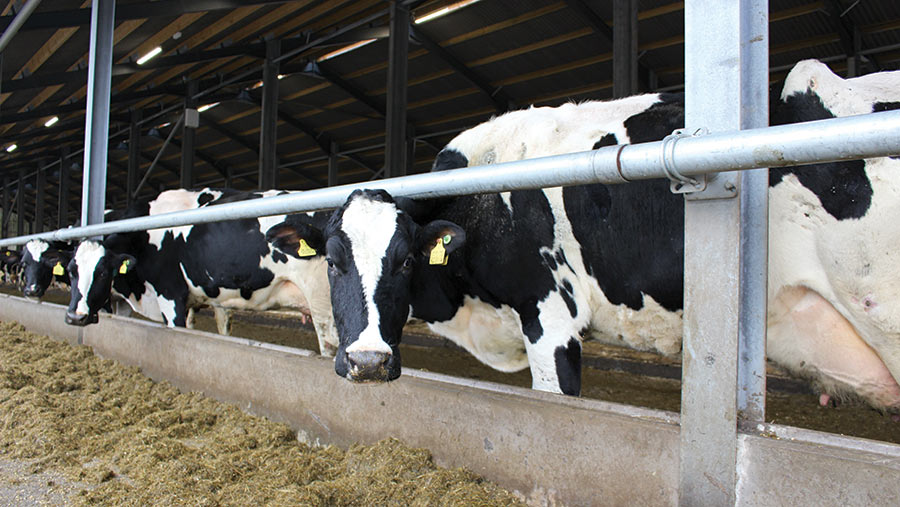7 farmer tips to fast track planning permission
 © Sarah Alderton
© Sarah Alderton Taking the time to identify the relevant site surveys for your build and engaging with the public will help smooth any planning application, says Cumbrian farmer Robert Morris-Eyton.
In 2018, Mr Morris-Eyton put forward a planning application for a new 400-cow shed and rotary parlour on a greenfield site at Beckside Farm, Millom, in the Lake District National Park.
Approval was received in just 12 weeks and the buildings erected within about six months.
The new build is located about 150m away from the existing dairy building complex, which is connected via a concrete lane. The new set-up means the business is on track to expand from 250 to 400 cows this year.
See also: Planning for housing on farmland – 6 steps to success
Farm Facts
- Beckside Farm, Millom, Cumbria
- 263ha plus grazing rights
- 350 cows, increasing to 400 head
- 11,000 litres a cow a year
- Robert Morris-Eyton runs the unit with wife Rowena and his son, Patrick – a Farmers Weekly Livestock Farmers Focus writer
- 850 fell ewes
- Hydro power and building business
As a qualified chartered surveyor, Mr Morris-Eyton has an excellent understanding of all aspects of the planning process.
He runs Farmers Weekly through some key learnings from his own planning application process. You can also read more about the parlour and cubicle shed in What’s in Your Livestock Shed visits a £1.4m greenfield dairy
1. Bring in specialists
Planning is not for the faint-hearted. There’s a lot to it and it is technical. Speak to a building specialist to sketch out the building and someone with planning experience such as a chartered surveyor.
Do your homework and pick the right people. We used a specialist from Devon for the slurry lagoon planning, who had written the guidelines for the Environment Agency (EA).
2. Be prepared to spend
You could spend an amount equivalent to the planning application fee in getting the application ready.
Our planning fee to the National Park was £25,000 – although usually this would go to the council.
I did a lot of the preparation, but if you paid someone to do everything, it could cost another £20,000 for a similar-sized development.
3. Identify any issues before the application
I’d recommend speaking to the EA before getting too far with designing any slurry storage.
We invited them out first and they suggested tweaks to where we would site the lagoon.
Speak to the planners before you progress, and work out where the building would fit in the landscape and whether it would work aesthetically.
4. Provide planners with everything they need
There are a lot of reports that go with an application. That’s why employing a specialist is useful as they will know what is required.
Submitting all necessary documentation with the application will increase the chances of planning going through quickly (see tips box, below).
I’d recommend carrying out an ecology report as this will highlight any ecological issues that may require mitigation. Worse-case scenario, it could stop the project all together.
We knew we had protected hedgerows, so we said in our application that we would relocate them. However, most people would opt for compensatory planting elsewhere.
Showing that you’re going to put in extra trees may also help. We probably put in about 200-300 trees.
Our building specialist, Ivor Davey of CowPlan, also produced a 3D video of the proposed development and used Google Earth to show how it would fit in its surroundings.
The £2,000 cost was well worth it because people often struggle to visualise how big something is and how it fits in the location. I also had the support of chartered surveyor Julie Liddle of Robson & Liddle.
5. Explain the reasoning behind the design
In the design statement that accompanies the planning application, we explained why we needed certain aspects of the building for cow welfare. For example, we explained that we needed the buildings 25m apart for ventilation.
If you need the eaves to be 4m high with a 20deg pitch roof, explain why – it will avoid it getting thrown back stating it needs to be 3m with a 17-deg pitch, for example.
6. Consider building materials
What are the normal building materials for the area? There’s more chance of getting planning agreed if it’s aesthetically pleasing. Our roof is anthracite grey and the weather boarding is treated green timber.
7. Engage with the public

© Robert Morris-Eyton/CowPlan
Video
We used the 3D video of the proposed development on our Facebook page before planning was submitted.
We knew the proposal was sensitive because we are in the Lake District National Park, so we thought it beneficial to get it out there.
I think it helped. If people don’t know what’s going on, rabbits can start running with misinformation. I think it’s down to personal choice as to when you go public prior to the application.
In some areas where objections may be expected, it could give the public more time to think about it.
I also took the opportunity to attend a Whicham Parish Council meeting prior to our application.
I spoke to the councillors, put up the 3D video and explained what we were doing and why. It was very well received.
They were pleased to have an opportunity to see the visuals and how it would look in the landscape.
